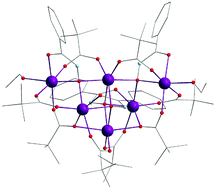The strategic recombination of preformed coordination clusters in the presence of polymodal bridging ligands has successfully led to the characterisation of five new compounds of structural and magnetic interest. Indeed using the dinuclear complex [M2(H2O)(piv)4(Hpiv)4] (M = Co, Ni; Hpiv = pivalic acid) as starting material and reacting it with phenylhydroxamic acid (H2pha) has yielded the four tetrametallic coordination clusters [Co4(Hpha)2(piv)6(Hpiv)4] (1), [Ni4(Hpha)2(piv)6(Hpiv)2(DMF)2] (2), [Co4(Hpha)2(piv)6(EtOH)2(H2O)2] (3), [Ni4(Hpha)2(piv)6(EtOH)2(H2O)2] (4) and the hexanuclear complex [Co6(Hpha)4(piv)8(EtOH)2]·EtOH (5). All the compounds have been structurally characterised revealing a particular binding mode for the hydroxamate ligand. The study of their magnetic properties has been performed and the modelling of these properties has been done using the appropriate hamiltonians for each compound. The experimental data and their modelling show non-zero spin ground states for compounds 4 and 5.

